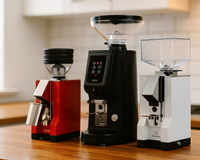Brewing Patience: Exploring the Reasons Why Prosumer Espresso Machines are Slow to Heat Up
For coffee enthusiasts who want to enjoy a high-quality espresso experience in the comfort of their own homes, investing in a prosumer or high-end espresso machine is often the way to go. These machines come with advanced features and design elements that allow users to create cafe-level espresso drinks with precision and consistency. However, one of the most common issues that users of these machines face is the long heat-up time. In this blog post, we will explore the reasons why prosumer/high-end espresso machines take so long to heat up, and what factors contribute to this. We will also provide some tips on how to manage the heat-up time and optimize your machine's performance. But first, let's start with some background information on espresso machines in general.
Shop all our prosumer espresso machines >
What is a prosumer espresso machine?
A prosumer espresso machine is a type of espresso machine that is designed for home use but includes features and specifications that are similar to those found in commercial espresso machines.
The term "prosumer" comes from the combination of "professional" and "consumer," indicating that these machines are intended for serious home baristas who want to achieve a high level of control and precision in their espresso-making. Prosumer espresso machines typically include advanced features such as PID temperature control, pressure profiling, and multi-boiler systems, which allow users to fine-tune their brewing process and produce consistent and high-quality espresso shots. These machines are usually larger, more powerful, and more expensive than standard home espresso machines, but they offer greater control and flexibility for those who are serious about their espresso-making.
Related Article: Espresso machines with the fastest warm-up times
Different types of heating systems
There are two main heating systems used in espresso machines: thermoblocks and boilers. Here's an overview of each system and how it affects the heat-up time:
Thermoblock heating system:
- A thermoblock is a small, self-contained heating unit that is used in some espresso machines to heat the water for brewing.
- The thermoblock consists of a metal block with a heating element inside, which heats the water as it flows through a channel or tube in the block.
- The advantage of a thermoblock system is that it heats water quickly, typically in about 30-60 seconds, making it a good choice for machines that prioritize speed and convenience.
- However, thermoblocks can have issues with temperature stability, as the water is only in contact with the heating element for a short amount of time, which can lead to fluctuations in temperature.
Boiler heating system:
- A boiler is a larger, more traditional heating system that is used in many espresso machines, both commercial and home.
- The boiler consists of a metal tank that is filled with water and heated by an electric heating element or a gas flame.
- The advantage of a boiler system is that it offers excellent temperature stability, as the water is in constant contact with the heating element and can be kept at a consistent temperature.
- However, boilers take longer to heat up than thermoblocks, typically taking several minutes to reach operating temperature.
- Boilers can also be more complex and require more maintenance than thermoblocks, as they need to be descaled regularly to prevent mineral buildup.
Thermoblocks are a good choice for espresso machines that prioritize speed and convenience, while boilers offer excellent temperature stability but take longer to heat up and require more maintenance. The choice between these systems depends on the user's priorities and preferences, as well as the specific features and design of the espresso machine.
So why do they take so long to heat up?
Prosumer/high-end espresso machines take longer to heat up than standard home espresso machines primarily because of their larger size and more powerful heating systems. Here are some factors that contribute to the longer heat-up time:
-
Size and volume: Prosumer/high-end espresso machines are typically larger than standard home machines and have a higher water capacity, which means that more water needs to be heated to reach the desired temperature.
-
Heating power: Prosumer/high-end machines often have more powerful heating elements or multiple boilers, which can take longer to heat up but provide better temperature stability and more precise control over the brewing process.
-
Temperature stability: As mentioned earlier, maintaining temperature stability is crucial for making high-quality espresso, and prosumer/high-end machines are designed to prioritize this over speed. This means that they may take longer to heat up in order to reach and maintain a stable temperature.
-
Construction and materials: Prosumer/high-end machines are often constructed with higher-quality materials, such as stainless steel or brass, which can take longer to heat up than plastic or aluminum.
-
Safety features: Prosumer/high-end machines may include safety features such as overpressure valves or automatic shutoffs, which can also contribute to a longer heat-up time.
Overall, while the longer heat-up time of prosumer/high-end espresso machines may be a minor inconvenience, it is a tradeoff for the advanced features and quality that these machines offer. With proper use and maintenance, these machines can provide years of high-quality espresso enjoyment.















